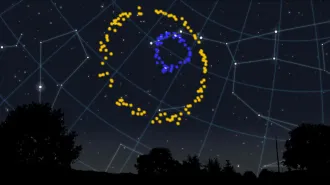Astronomers stoke cosmic debate
More heat than light from a dispute over the universe's dark side
Though dark energy and dark matter rank among the more mind-boggling concepts in astronomy, they appear to be necessary evils.
Theorists summon dark energy, the mysterious entity that transforms gravity from a cosmic pull to a cosmic push to account for the accelerating expansion of the universe. Meanwhile dark matter, the proposed invisible material theorists say makes up more than 80 percent of the universe’s mass, keeps galaxies intact and galaxy clusters from flying apart.
Now, two astronomers say they can banish the dark side of the universe to the dust heap of ill-conceived theories. But other astronomers aren’t getting too revved up about the tentative findings.
In an article in press in the Monthly Notices of the Royal Astronomical Society, astronomers Utane Sawangwit and Tom Shanks of Durham University in England argue that there are flaws in astrophysicists’ analysis of tiny temperature fluctuations in the cosmic microwave background — the whisper of radiation left over from the Big Bang.
In particular, the temperature ripples recorded by NASA’s Wilkinson Microwave Anisotropy Probe, or WMAP, may be smaller than indicated by the probe’s telescope, the researchers say. WMAP scientists calibrate the telescope by using microwave emissions from Jupiter as a standard source. By determining how much the instruments on WMAP blur the Jovian microwave emissions, assumed to be steady, the scientists can figure out how much the telescope blurs the emission left over from the Big Bang, and correct for that instrumental error.
But when Sawangwit and Shanks calibrated the WMAP data in a different way by using microwave emissions from distant pointlike sources, they concluded that the telescope blurs signals more than the WMAP scientists have calculated. If Swangwit and Shanks are correct, it would mean the temperature fluctuations in the microwave background aren’t as large as is thought. Because the size of the ripples is thought to be connected to the composition of the universe, smaller ripples would weaken the evidence for the universe’s dark side.
Not so fast, says theorist David Spergel of Princeton University, a member of the WMAP team. Spergel says his colleague Gary Hinshaw of NASA’s Goddard Space Flight Center in Greenbelt, Md., has carefully examined the Durham team’s claim and found it wanting. Biases in the way the Durham researchers analyzed the data can account for their surprising finding, Spergel says. In particular, Hinshaw finds, the microwave emissions from the distant sources happen to coincide with regions where the microwave background is hotter than average. More heat means more blurring.
Shanks counters by noting that a reviewer raised the same point when the paper was being considered for publication. “We had made simulations to check for this effect and found no problem,” he says. ”The referee was satisfied that the WMAP team did have a case to answer and the paper was accepted.”
This isn’t the only way Shanks and his colleagues are trying to put the kibosh on dark energy. In a separate paper published in the Monthly Notices of the Royal Astronomical Society, the researchers compare hot spots in the microwave background — regions of higher than average temperature — with the locations of galaxy clusters. If dark energy exists, the hot spots should match up with the cluster locations, as indicated by a survey of 1 million luminous red galaxies recorded by the Sloan Digital Sky Survey. The researchers find no such match.
Stay tuned for how it all shakes out. But chances are that Spergel and other theorists won’t easily give up on dark energy or dark matter, whose existence explains many puzzles about the universe. Any rumors of their death are likely to be greatly exaggerated.







